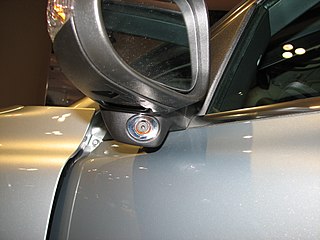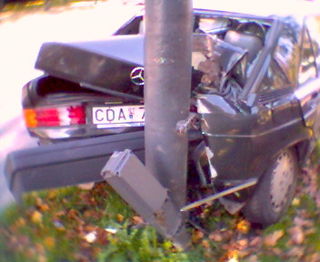
Advanced driver-assistance systems (ADAS) are technologies that assist drivers with the safe operation of a vehicle. Through a human-machine interface, ADAS increase car and road safety. ADAS use automated technology, such as sensors and cameras, to detect nearby obstacles or driver errors, and respond accordingly. ADAS can enable various levels of autonomous driving.

The Cadillac Calais is an automobile that was the entry-level Cadillac model that was sold from 1965 to 1976. Cadillac renamed its low-priced Series 62 in 1965 as the "Calais", after the French port city of Calais that overlooks the narrowest point in the English Channel. In Greek mythology, Calais was one of two winged sons of Boreas, god of the North Wind, and Oreithyea. With the exception of no convertible model, the Calais shared the same styling and mechanics as the better-equipped, more expensive Cadillac de Ville.

A rear-view mirror is a, usually flat, mirror in automobiles and other vehicles, designed to allow the driver to see rearward through the vehicle's rear window.

The Volvo Safety Concept Car (SCC) is an ESV concept car which was first shown at the 2001 North American International Auto Show in Detroit, Michigan. The SCC incorporates the rear hatch design from Volvo P1800ES and the glass hatch from Volvo 480ES.

The pillars on a car with permanent roof body style are the vertical or nearly vertical supports of its window area or greenhouse—designated respectively as the A, B, C and D-pillar, moving from front to rear, in profile view.
A glossary of terms relating to automotive design.

Emergency vehicle equipment is any equipment fitted to, or carried by, an emergency vehicle, other than the equipment that a standard non-emergency vehicle is fitted with.
The Nissan Pivo is a series of electric concept cars created by Nissan, with the first one introduced in 2005 at the Tokyo Motor Show.

The blind spot monitor or blind-spot monitoring is a vehicle-based sensor device that detects other vehicles located to the driver’s side and rear. Warnings can be visual, audible, vibrating, or tactile.

Parking sensors are proximity sensors for road vehicles designed to alert the driver of obstacles while parking. These systems use either electromagnetic or ultrasonic sensors.

Automatic parking is an autonomous car-maneuvering system that moves a vehicle from a traffic lane into a parking spot to perform parallel, perpendicular, or angle parking. The automatic parking system aims to enhance the comfort and safety of driving in constrained environments where much attention and experience is required to steer the car. The parking maneuver is achieved by means of coordinated control of the steering angle and speed which takes into account the actual situation in the environment to ensure collision-free motion within the available space.

A backup camera is a video camera that is produced specifically for the purpose of being attached to the rear of a vehicle to aid in reversing and to reduce the rear blind spot. The rear blind spot has been described as a "killing zone" because of the accidents it contributes to. Backup cameras are usually connected to the vehicle's head unit display. A common variant is a surround-view system, which assembles a synthetic but positionally accurate top-down view of the vehicle and its adjacencies.

A side-view mirror, also known as a wing mirror, is a mirror placed on the exterior of motor vehicles for the purposes of helping the driver see areas behind and to the sides of the vehicle, outside the driver's peripheral vision.
The following outline is provided as an overview of and topical guide to automobiles:

The phrase "objects in (the) mirror are closer than they appear" is a safety warning that is required to be engraved on passenger side mirrors of motor vehicles in many places such as the United States, Canada, Nepal, India, and South Korea. It is present because while these mirrors' convexity gives them a useful field of view, it also makes objects appear smaller. Since smaller-appearing objects seem further away than they actually are, a driver might make a maneuver such as a lane change assuming an adjacent vehicle is a safe distance behind, when in fact it is quite a bit closer. The warning serves as a reminder to the driver of this potential problem.

Back-up collisions happen when a driver reverses the car into an object, person, or other car. Although most cars come equipped with rear view mirrors which are adequate for detecting vehicles behind a car, they are inadequate on many vehicles for detecting small children or objects close to the ground, which fall in the car's blind spot, particularly directly aft. That area has been called a "killing zone." Large trucks have much larger blind spots that can hide entire vehicles and large adults.

The fifth-generation Subaru Legacy was originally unveiled as a concept car at the 2009 North American International Auto Show in Detroit to commemorate the 20th anniversary of the model, and the production version was introduced at the 2009 New York International Auto Show. Production of the fifth generation started on 29 May 2009.
Omniview technology is a vehicle parking assistant technology that first was introduced in 2007 as the "Around View Monitor" option for the Nissan Elgrand and Infiniti EX. It is designed to assist drivers in monitoring their surroundings, for example, while parking a vehicle in a small space.

Back-in angle parking, also called back-in diagonal parking, reverse angle parking, reverse diagonal parking, or reverse echelon parking, is a traffic engineering technique intended to improve the safety of on-street parking.




























